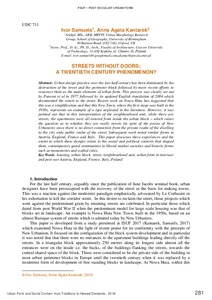STREETS WITHOUT DOORS; A TWENTIETH CENTURY PHENOMENON?
Скачать файл:
URI (для ссылок/цитирований):
https://elib.sfu-kras.ru/handle/2311/111699Автор:
Samuels, Ivor
Kantarek, Anna Agata
(Samuels, I, Kantarek, A.A.: 1AAdipl. MSc. ARB, MRTPI, Urban Morphology Research Group, School of Geography, University of Birmingham 49 Bainton Road, OX2 7AG, Oxford, UK 2Assoc. Prof., D. Sc., Ph. D., Arch., Faculty of Architecture, Cracow University of Technology, 31-450 Kraków, ul. Ułanów 28, Poland E-mail: ivor.samuels@googlemail.com,akanta@poczta.onet.pl)
Дата:
2019-05Proceedings of the XXV ISUF International Conference “Urban Form and Social Context: from Traditions to Newest Demands” (Krasnoyarsk, July 5–9, 2018)
Аннотация:
Urban design practice over the last half-century has been dominated by the destruction of the street and the perimeter block followed by more recent efforts to resurrect them as the main elements of urban form. This process was clearly set out by Panerai et al in 1977 followed by its updated English translation of 2004 which documented the return to the street. Recent work on Nowa Huta has suggested that this was a simplification and that this New Town, where the first stage was built in the 1950s, represents an example of a type neglected in the literature. However, it was pointed out that in this interpretation of the neighbourhood unit, while there are streets, the apartments were all entered from inside the urban block – which raises the question as to whether they are really streets (in spite of the praise of New Urbanists) since there is no direct connection from the private realm of the dwelling to the city wide public realm of the street. Subsequent work noted similar forms in Austria, England, France and Italy. This paper discusses these experiences and the extent to which these designs relate to the social and political contexts that shaped them, contemporary gated communities in liberal market societies and historic forms such as monasteries and walled cities.

